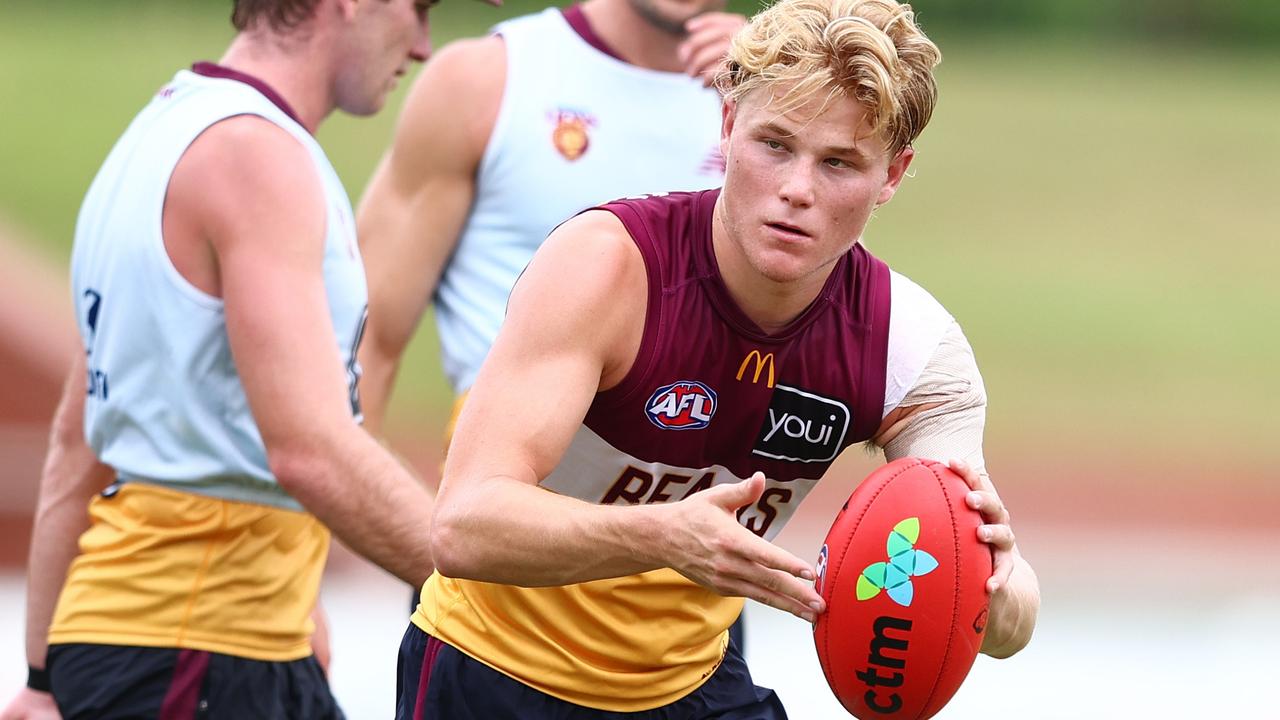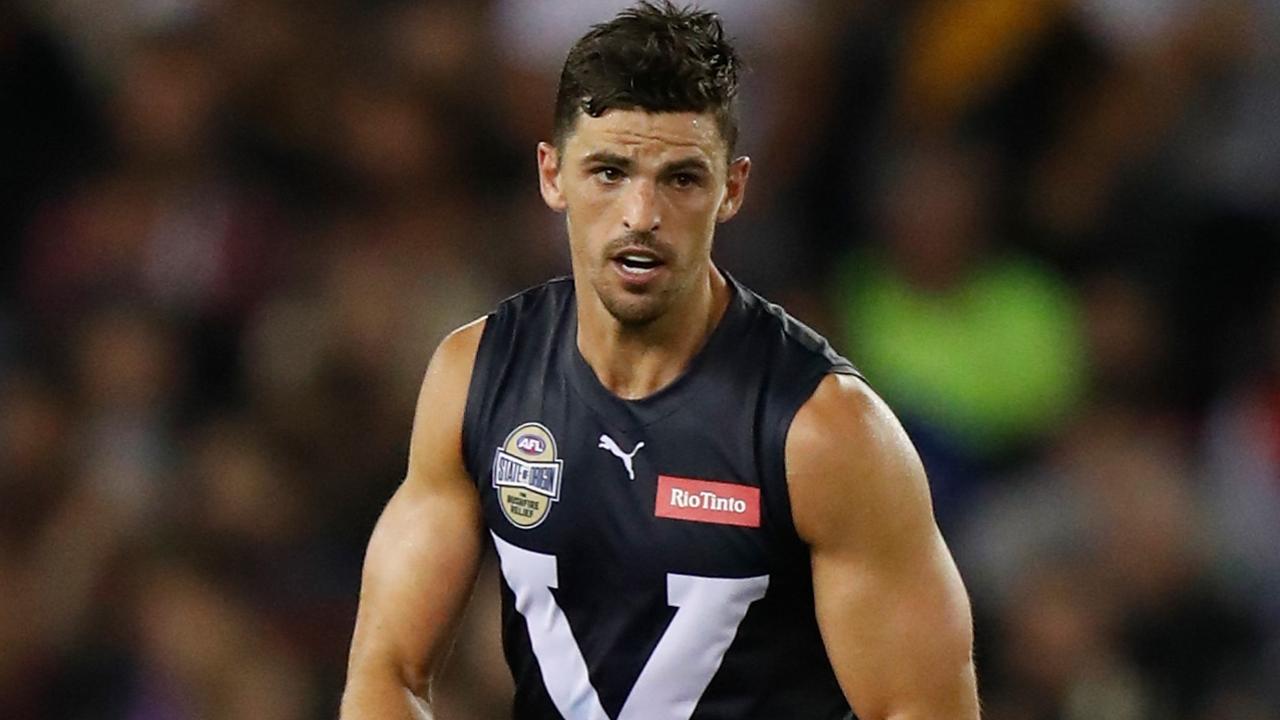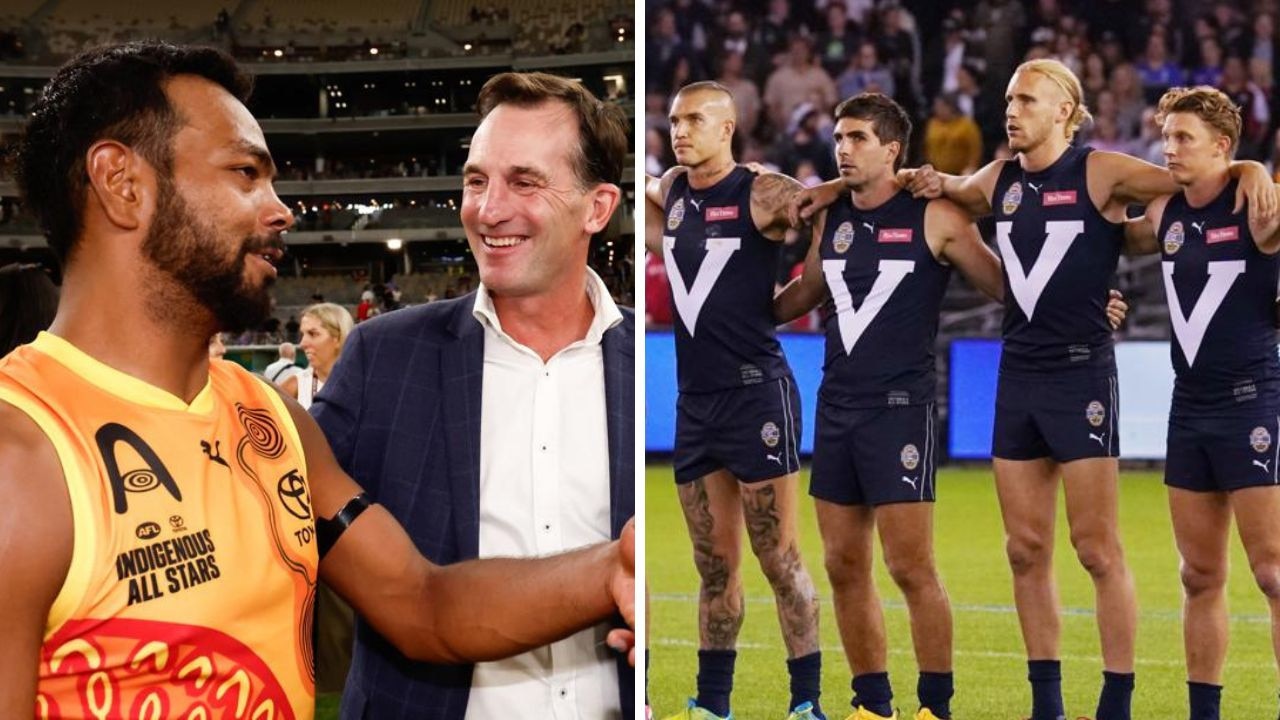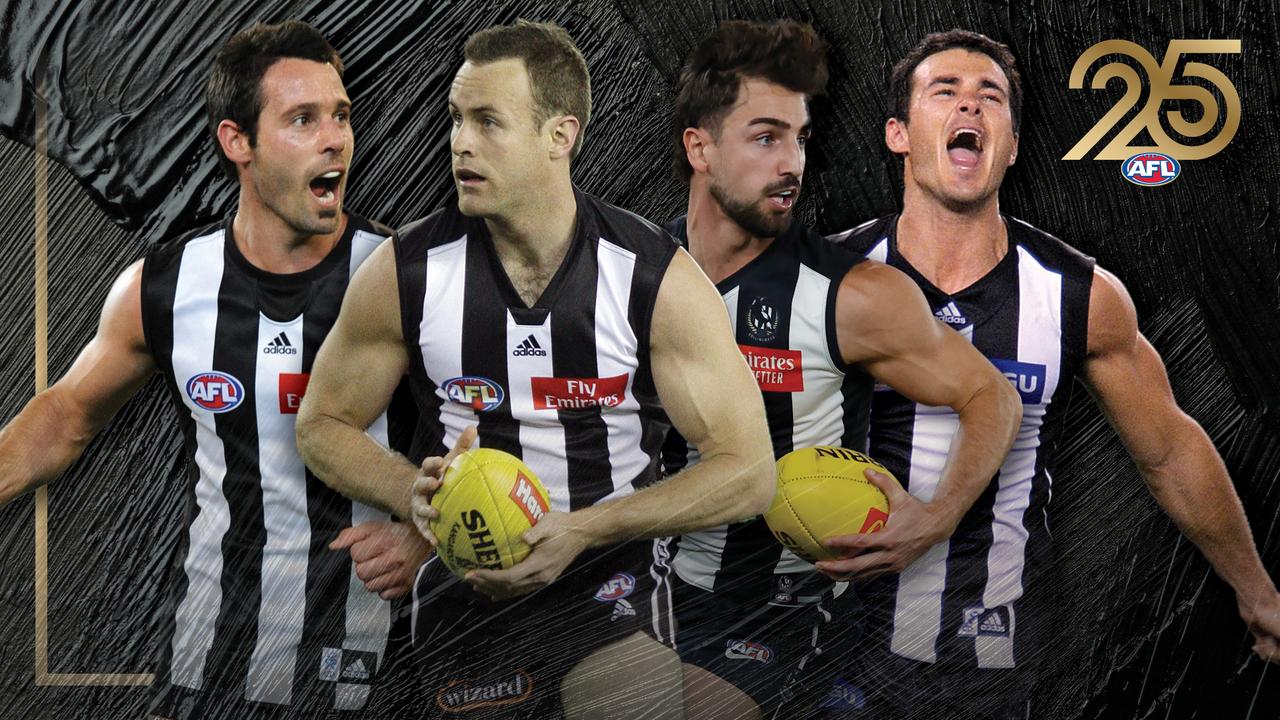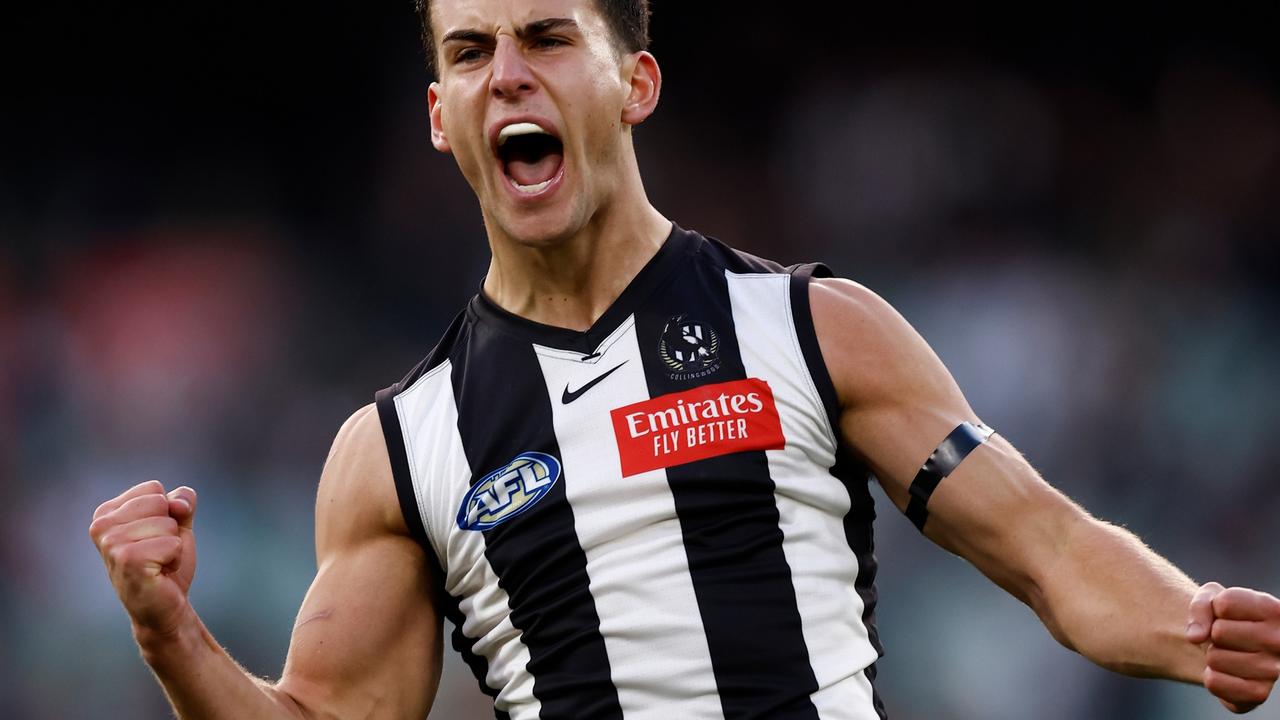How Geelong, Sydney built their grand final lists
A 2022 premiership would be Geelong’s greatest list management achievement of the modern era. See how the Cats and Swans used savvy trades and recruiting to build grand final lists.

AFL
Don't miss out on the headlines from AFL. Followed categories will be added to My News.
Geelong’s list management crew would be great at a garage sale.
On Saturday, a club which has already won three flags over the past 15 years will shoot for a fourth premiership the league’s equalisation measures were designed to prevent.
In the 2007, ’09, and ’11 triumphs, the Cats shot the lights out at the draft, and hit the jackpot on the father-son rule.
But, if successful, it’s this next opportunity to climb back up on to the premiership dais which looms as the most impressive from a list build perspective.
The major difference between the previous Geelong premiership team and this one is that as much as the Cats might have been tempted to head back to the draft like a lot of other clubs after 2011, there was a major pivot in direction.
They accessed talent using other means.
Ten years ago, the two new franchise clubs gobbled up the bulk of the early draft picks, just as the Cats needed to replenish their squad.
And when Chris Scott’s team run out on to the MCG on Saturday, there will be only two players taken with single-figure draft selections: Joel Selwood, 34, and Gary Rohan, 31.

Jeremy Cameron was a GWS pre-draft selection and Tom Hawkins was father-son.
So, with football’s equivalent of all the new car showrooms shut to the Cats, list bosses Stephen Wells and Andrew Mackie and their talent identification team have spent the past 10 years at second-hand dealerships and auction rooms hunting bargains and pre-loved stars in trade, free agency and supplemental selections.
The Cats are specialists at the scratch-and-dent sales.
Rookie picks Tom Atkins, Jack Henry, Brad Close and Zach Guthrie were nabbed from footy’s discount bin, Max Holmes was netted from a savvy pick swap with Richmond on draft night, Tyson Stengle was welcomed back from the AFL scrap heap and Tom Stewart and Kade Kolodjashnij were chosen with picks in the 40s.
They were doubts on Gryan Miers’ kicking style, 11 clubs passed on Sam De Koning, and Isaac Smith, Zach Tuohy and Rhys Stanley already had plenty of entries stamped into their service log books when they crossed from rival clubs.
“They have certainly gone down a different path to what they did to win their last three premierships,” a talent expert said.
“So it is definitely unique in the sense that instead of doing the same thing as they did last time largely through the draft, they really embraced all the different opportunities available to them to put the list together in a different manner this time.
“Everyone at the club would take special enjoyment out of that. More than anything, what they have shown as a footy club is they have been prepared to adapt.”
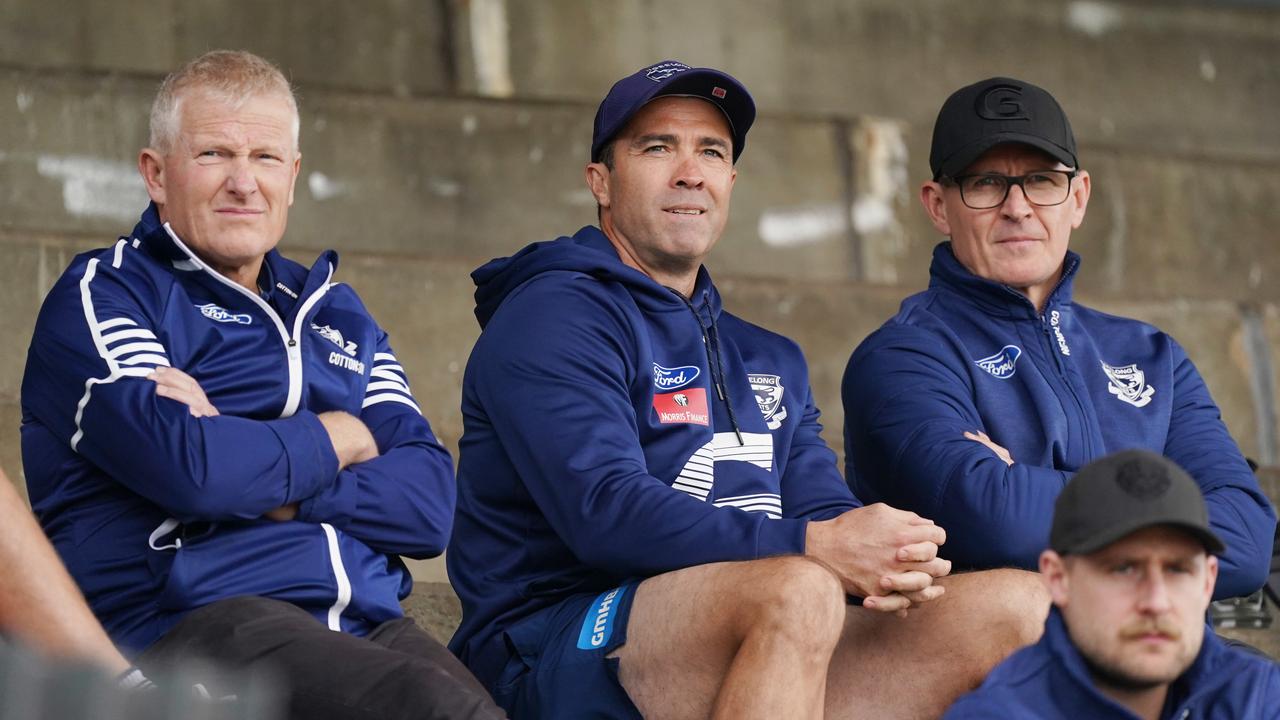
Clearly, Geelong’s geographical location close to the Surf Coast – and out of the Melbourne spotlight, where the costs of living are lower – has delivered the club an undeniable advantage.
Superstars Cameron and Patrick Dangerfield were never headed to the big smoke to raise their families, instead opting for the more laid-back lifestyle perhaps only the Cats can offer.
But the greatest success was that Geelong was brave enough to buck some conventional recruiting trends, believing in what players can offer late in their careers.
There was also a huge emphasis on players’ versatility, knowing how quickly the trends in games can change, according to Wells’ former right-hand man Luke Williams.
That’s Mark Blicavs, who can play anywhere from key defender, ruck, wing and midfield tagger, and Atkins, who has gone from small forward to the back pocket, to midfield wrecking ball.
Henry swings from attack to defence and Holmes rotates from outside to inside midfield. Even Stewart, who is the best rebounding defender in the game, spent time on a wing this year.
Williams, who is talent boss at the Western Jets, said that focus on flexibility has been a recruiting trump card.
“Geelong may pick an 18-year-old who plays half-back but there will be other parts of their game that can be transferred into other roles to make them a versatile player,” Williams said.
“That allows players drafted later in the draft to develop and build into more prominent roles.”
The Cats have also maximised their draft opportunities outside the first round.
In the ’09 and ’10 drafts, the Cats hit the jackpot taking star playmakers Mitch Duncan (pick 28) and Cameron Guthrie (23).
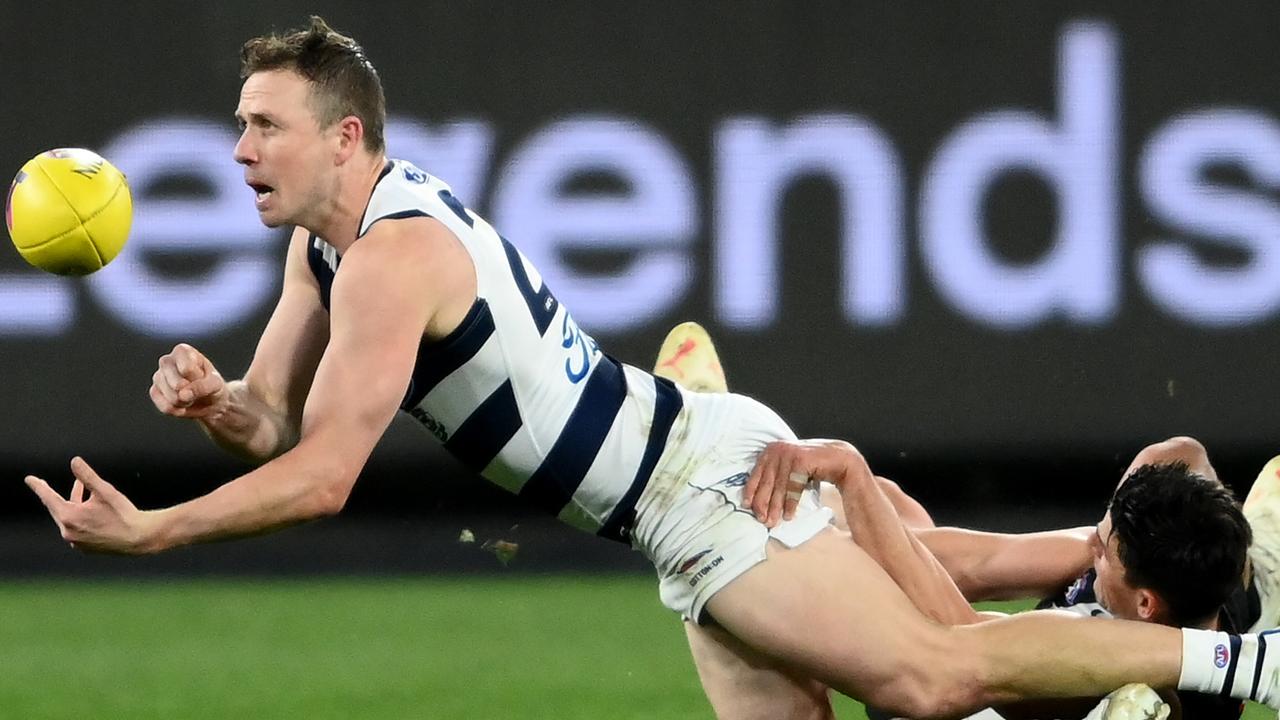
At the Guthrie pick, it came down to ruckman Scott Lycett and the hard nut, who former premiership captain Cameron Ling this week said was the Cats’ best midfielder.
Williams said Guthrie and Duncan symbolised what the Cats valued highly in terms of their versatility, consistency, discipline and competitiveness, even though they may not have had any spectacular traits in their draft years.
“They were two players who were good at most things but probably not outstanding back then, because you look at someone like Shai Bolton and he has got something with his agility and skill level that most players don’t have,” Williams said.
“Recruiters are always looking for that something extra in players, something special.
“But Cam and Mitch were both a bit the same in the sense they were above average in most things, or everything.
“Good kicks, balance, footy IQ. Both were needing to put on size and maybe needed to be more consistent with their contested ball-winning back then.
“Both were really well-rounded players in the talent pathway without being superstars at the time, and perhaps there was a perception there wasn’t a lot of upside in some of them.
“But in terms of that versatility piece, the game is always trying to be fast-paced and skilful and that has been proven with the rule changes.
“Cam and Mitch were smart enough and skilful enough to adapt to the changes in the game.”

Add to that Geelong’s highly-rated coaching and development program, a culture created by former captains Tom Harley and Ling, ex-CEO Brian Cook and former president Frank Costa, Selwood and ex-coach Mark Thompson, among others.
Plus, as any recruiter will tell you, a slice of luck.
In the 2019 draft at pick 19, Geelong wanted a cornerstone big man. A prized key-position player.
At pick 18, Port Adelaide took Mitch Georgiades, leaving De Koning for the Cats.
It was a sweet spot, as either player would have been an outstanding addition at a point in the draft where premium talls can be much harder to find.
But De Koning, 21, has been a revelation in his third season, taking down some of the league’s top key forwards.
Similarly, Richmond seemingly did the Cats a favour in 2020 when the Tigers handed over their pick 20 in exchange for Geelong’s future first-round selection in 2021.
With Richmond’s pick, the Cats nabbed Holmes, who has provided some of the brilliant run the Cats needed on the wing, helping ignite an ageing midfield brigade.
But he has shone on the inside, as well.
After his first pre-season practice game, Dangerfield made a beeline for Geelong officials to let them know he thought the hard-running kid was already ready to go.
Holmes was a bolter and, remarkably, the lightly-framed playmaker made his debut in round 3, only months after he was drafted. This was the Cats doing their thing, once again.
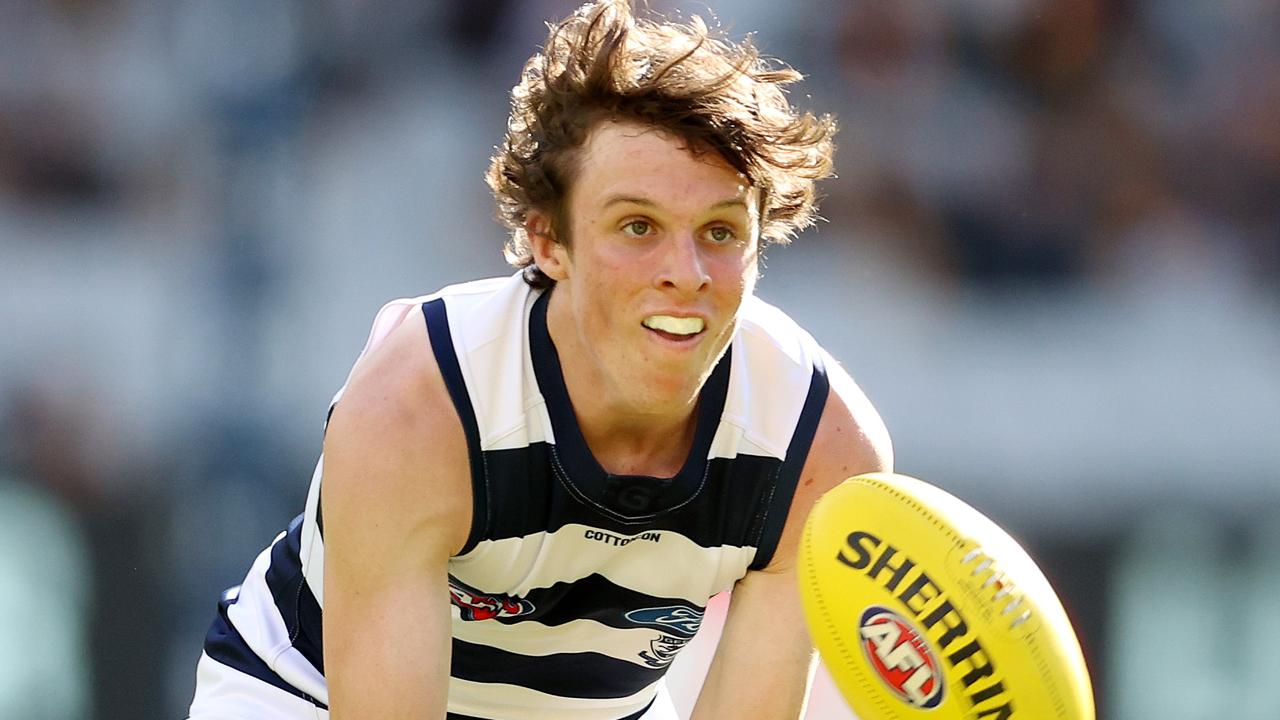
Sandringham Dragons talent manager Mark Wheeler said it was outstanding talent identification considering Holmes’ limited pre-seasons and exposure in his draft year.
They had unearthed another gem.
“He was someone who took the game on and ‘Wellsy’ loves that style of player,” Wheeler said.
“He’s definitely a Geelong pick because he has elite speed, he picks the ball up cleanly, he could win his own ball and he is a booming kick.
“He had all-round skill, but clearly his athletics background helped him.
“I was a bit shocked when Geelong traded (so early in the order) to get him, but clearly they knew at the next pick (Melbourne’s Jake Bowey), or the pick after (Melbourne’s Bailey Laurie), he would be gone.
“So they Cats had a rough insight this kid was not going to be there so ‘Wellsy’ jumped pretty quick.”
How Swans built a grand final list
– Marc McGowan
All the Swans’ investigating told them the same thing.
Chad Warner wasn’t a polished product as an 18-year-old – hence him still being available at pick 39 in the 2019 draft – but there was a reason he had Sydney’s attention.
Swans list boss Kinnear Beatson and national recruiting manager Simon Dalrymple saw Warner step up in big moments, whether that be for Western Australia or with East Fremantle.
They saw his insatiable appetite for the contest and some of the power and explosive speed he now displays regularly as one of the game’s rising stars.
But there was more: Sydney’s interviews with Warner’s coaches, teachers and other peripheral people aligned with what the club’s psych evaluation revealed about the then-teenager.
“He wasn’t a stresser or over-thinker,” Dalrymple told News Corp.
“He’s one of those kids who just puts it all out there and doesn’t hold back, which is what you’re looking for.
“Some kids get anxiety and it means they don’t display the traits they showed in the under-18s – the big stage gets to them a bit. It’s something that’s hard to measure, but our information on Chad was pretty consistent.”
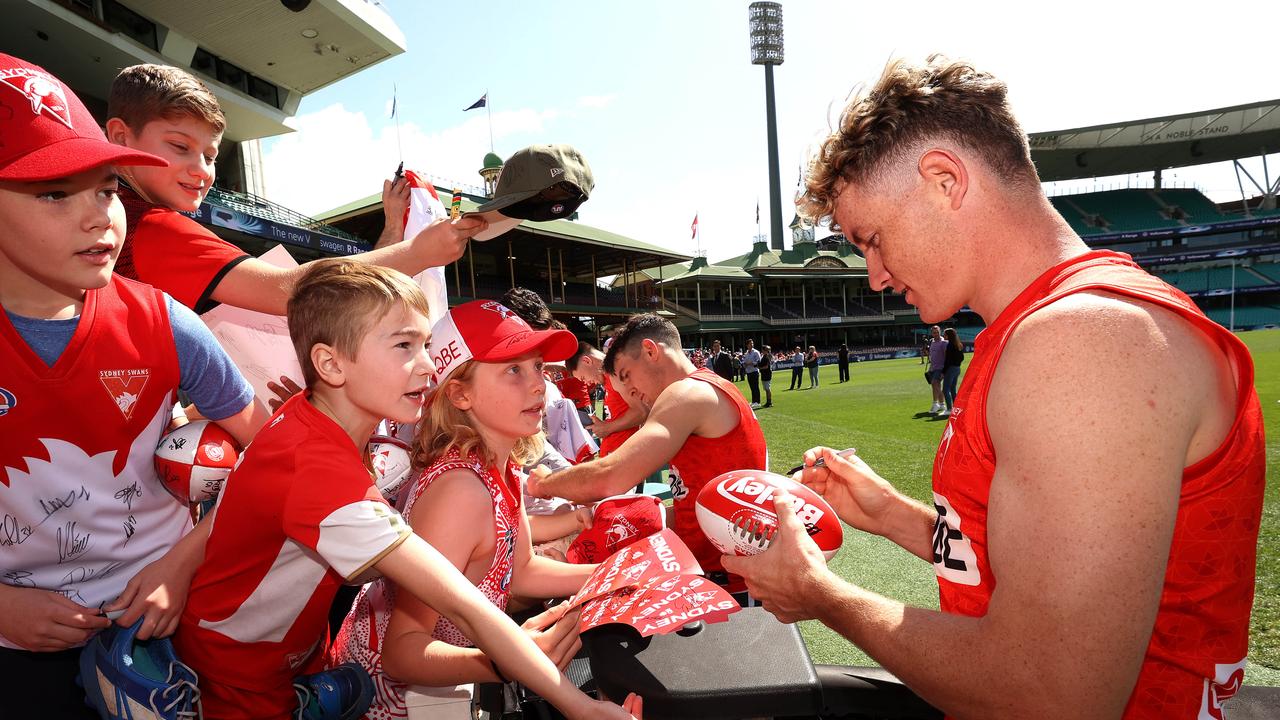
Beatson has long been regarded as one of the AFL’s best recruiting minds, having also helped orchestrate Brisbane’s flag three-peat from 2001-03 before joining the Swans.
More recently, the 65-year-old ascended to the role of Sydney’s list boss, with Dalrymple crossing from the Western Bulldogs at the start of 2018 to head up recruiting.
Together, they have been critical in fast-tracking the Swans’ rebuild with some draft bargains and savvy recruiting, from Warner, James Rowbottom and Justin McInerney to Tom Hickey and Paddy McCartin.
Sydney has benefited from recent Academy graduates Nick Blakey, Braeden Campbell and Errol Gulden, while top-five picks Dylan Stephens and Logan McDonald are also set to be part of Sydney’s grand final team on Saturday.
The Swans were basically the only club willing to take a punt on McCartin, the No.1 draft pick in 2014 who found himself out of the league after a series of concussions.
McCartin’s agents, Winston Rous and Scott Lucas, of Phoenix Management Group, initiated discussions with Beatson, setting off a chain of events that paved the way for one of the fairytale stories of this season.
The 26-year-old entered the AFL as a hulking forward picked before Christian Petracca, but his rebirth as a footballer was as an intercepting defender alongside his brother Tom, who was also drafted as a forward.
Putting the list puzzle pieces in place is not always an exact science.
In between, Sydney did a huge amount of due diligence on McCartin that involved its own medical staff, external specialists and even the AFL, which had to give the green light for him to even play again.
“It’s such a complex issue and we certainly needed a lot more information from the experts before making a decision,” Beatson said.
“So we went down that path, got clearance for him to play for our VFL team last year, then Covid hit, he got suspended and he did his hamstring towards the end of the year, before the season came to a close.
“But he’d shown reasonable signs up to then and it fell into place that there’d be a chance for him to do the pre-season with us, because he was classified as a delisted free agent and didn’t have to nominate for the draft.”
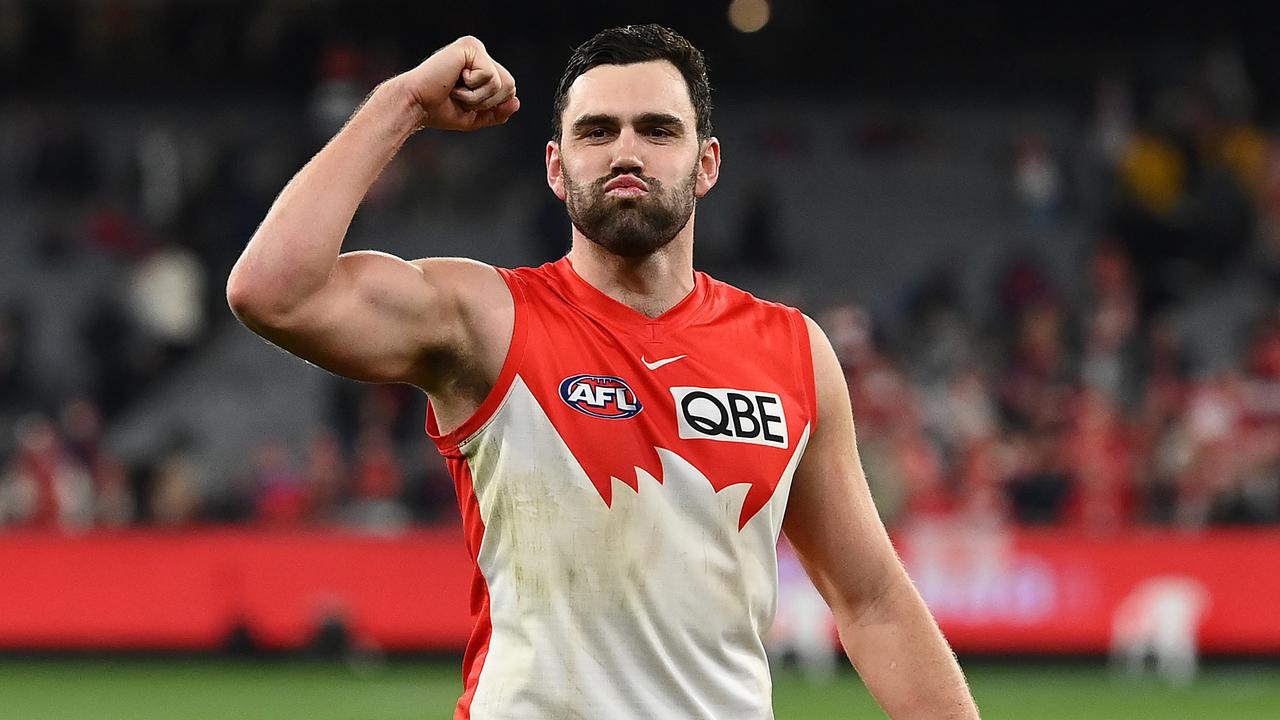
McCartin is effectively to the Swans what reformed forward Tyson Stengle is to grand final opponent Geelong, another club with a track record of sustained success that Beatson respects “enormously”.
“It’s about looking for where the opportunities lie,” Beatson said.
Admittedly, not every recruiting risk paid off.
Sydney selected Elijah Taylor three picks before Warner in 2019 and he showed enough promise to play four senior games in his debut season but was axed after a domestic violence incident.
Dalrymple remains satisfied with the process that led to Taylor’s drafting, which included various people from chief executive Tom Harley down.
“Sometimes you’ve got to be bold and prepared to take a risk,” Dalrymple said. “But it’s not always going to work.”
Another fateful twist played out around McCartin.
He and veteran Sam Reid battled over the summer for the same defensive role after the latter won one of the final list spots last year.
McCartin came out on top, leaving Reid’s role for this season unclear. Injuries created an opportunity for him to play as a forward again, while also serving as the back-up ruckman.
The 30-year-old ha been a revelation but is under an injury cloud for the grand final with an adductor strain.
When mentioning Reid, you must also bundle in unheralded pair Robbie Fox and Ryan Clarke, who have also been a part of the Swans’ rise from the bottom four in 2019-20 to potential premiers two years later.
“It would be fair to say at the start of the year we hadn’t banked on Foxy, Sammy and Ryan Clarke resurrecting their careers to the level they have,” Beatson said.
“They’ve been fantastic these last couple of months.”

There were other mid-season developments, too. Experienced defender Harry Cunningham’s abdominal strain changed the course of two teammates’ seasons.
Ollie Florent, who was in a form rut, was sent down back to cover Cunningham, opening a spot for Stephens on a wing after he had struggled to get a look-in.
Meanwhile, Cunningham has played only three times since round 7, while Sam Wicks was playing the defensive forward role that Clarke has snatched and run with after toiling away in the VFL as a midfielder.
It’s all part of the swings and roundabouts of list strategy.
Beatson will tell you how many premiership teams have players who were drafted in different positions to the ones they eventually excelled in, like Chris Johnson at the Lions back in the day.
Dalrymple has operated in largely the same way at Sydney as he did at the Bulldogs.
There’s a balance in everything, but he typically avoids chasing players to fit list holes and instead hunts for “elite traits that are transferable”.
That thinking drew Dalrymple to Aaron Naughton and his incredible marking ability, when he was still recruiting for the Dogs. It didn’t matter whether he played in defence or up forward.
Blakey, the No.10 pick in Dalrymple’s first draft at Sydney, started as a forward then played in the midfield, on a wing and even as a relief ruckman before finding his sweet spot as a dashing defender.
But both Beatson and Dalrymple agree that their healthy recruiting strike rate owes plenty to the Swans’ overall environment, just like their Cats counterparts.
There’s the steady hand of long-time coach John Longmire, as well as the commitment to developing players and often making them wait for their senior chance.
“It’s a real credit to John and the coaches and the whole club, in terms of it’s very much seen that we want to compete in finals every year,” Dalrymple said.
“That competitive nature being driven really helps the players develop and they know the standards that must be met.”
Watch Fox Footy’s massive line-up of Grand Final week coverage on Kayo including live pre-game, halftime and post-game coverage with full analysis from the best team in the business. New to Kayo? > Start your free trial now >
Originally published as How Geelong, Sydney built their grand final lists



